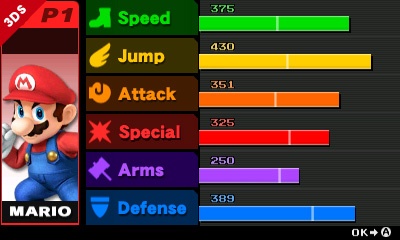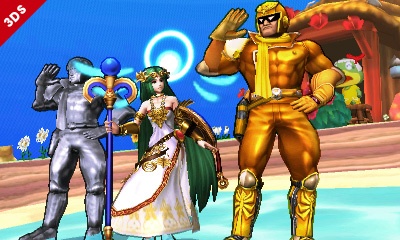


Super Smash Bros. for Nintendo 3DS is finally here, the latest brawling behemoth from Masahiro Sakurai and his team. It's been critically acclaimed, awarded 9/10 in our own review, and has proven that — despite some initial fears — the franchise arrives on the portable as a full-fat, fantastic game. With midnight launches on the eShop and many more besides no doubt going for the physical box option, we expect sales in the West to exceed the excellent launch it's had in Japan.
We've had some time with the game for review purposes, of course, so thought we'd bring together this guide to ease you into the new experience; if you want to know what treats await, we aim to cover it here. One thing we will do, however, is stick to official information or details that are there in the game right from the off. Any spoilers will be marked as such or linked to the relevant article elsewhere on the site — such as character reveals — to give you the best chance of only seeing the information you want to see.
That said, let's talk about Smash.
There are plenty of modes and variety available in Super Smash Bros. for Nintendo 3DS, so let's kick off with those that are specifically suitable for single (offline) players, and are all found in the Games & More section.
Training:
A vital mode for mastering the daunting roster of fighters. You have a great deal of control over your AI opponent, determining whether they simply stand still, walk towards you waiting to be thrashed or — if you're feeling feisty — fight back; you can even spawn specific items to improved familiarity with their uses.
Classic:
Called as such for a reason, this is a quickfire mode — you can rattle through in 10-15 minutes — in which you tackle six stages, concluding with an iconic face off with Master Hand or, if you want a greater challenge, that foe and an extra accomplice. These levels vary in challenge, as you tackle three opponents, team up with AI to tackle giant foes and more. The path also splits at each juncture, with alternate rewards and Trophy pick-ups available on each route.
This mode also includes an "Intensity" meter, like that seen in Kid Icarus: Uprising; this allows you to gamble gold coins on higher difficulty levels, with the benefit of higher levels bringing greater rewards. A Game Over offers a continue that deducts points and rewards, in addition to automatically lowering the selected level of intensity.
All-Star — also available in local multiplayer
Another returning mode in which you battle against the entire roster, with the choice of three difficulty levels. Each round will throw up 4-5 opponents, all appearing in chronological order of their first game appearances; this mode will expand as you unlock more characters.

Stadium
Target Blast — Its description as 'Smash does Angry Birds' isn't too far from the truth. With 10 seconds you quickly damage the bomb as much as possible before using a Smash move to propel it towards a sizeable structure full of point-scoring opportunities — you have two shots per round.
Home-Run Contest — Returning from previous entries, you have ten seconds to beat up the punch bag before launching it with a baseball bat; the higher the percentage you've inflicted on it, the further it'll travel.
Multi-Man Smash — in Stadium, also playable in local multiplayer
10-Man Smash — Obliterate 10 foes (mainly Mii fighters) as quickly as possible.
100-Man Smash — Obliterate 100 foes (mainly Mii fighters) as quickly as possible.
3-Minute Smash — Obliterate as many foes (mainly Mii fighters) as possible in 3 minutes.
Rival Smash (single player only) — Battle against a CPU rival (which uses the same character) to defeat as many Mii fighters as possible; the round ends when you or the CPU are knocked out of the arena.
Endless Smash — Fight hordes of Mii fighters and others until you're eventually defeated.
Cruel Smash — Take on other main characters from the roster in an exceptionally tough fight.
Trophy Rush — found in the Vault in Trophies
In this mode you pay a fair amount of gold to extend your time in the game. You then destroy as many falling boxes and blocks as possible to earn trophies.

Smash Run — single or local multiplayer
This is a new mode that's exclusive to the 3DS version. The basic format sets you in a large, variable area for five minutes; it's packed full of enemies and minions from throughout Nintendo's franchises. Your initial goal — shared by your three rivals — is to explore, find hidden chests, take on challenge rooms and destroy enemies. All of these activities bring you items and, most importantly, buffs. These boost key areas of your fighter's performance such as speed, strength, jumping, defence and smash power. The priority in those five minutes is to boost your abilities as far as possible before a final quickfire battle among the four competitors, each powered up from the initial round. The format of this final battle is also random, with some occasions of being in teams, others where the Star item is repeatedly spawned and so on.
Smash Run has plenty of depth beyond that core format. Items and moves that you collect — throughout the game — are customised onto your fighter of choice; you can use previously used setups, equip a new character and create multiple customisations of any given fighter. You can also select a 'default' or 'random' setting, but customisation allows you to adjust the focus to Attack, Defence or Speed by applying equiment, customise Specials and select Powers that can be activated in the first phase of the mode. Attention to these details can greatly boost your odds of success — more on this in our Character Customisation section below.
This mode is fun Solo, but local multiplayer Group matches should provide plenty of competitive edge, with matches that take less than 10 minutes to complete. As a neat bonus you can also select any track to play as selected from the unlocked soundtrack.

Smash — single or local multiplayer
This is the mode that most will be familiar with from throughout the franchise, which started it all and remains the core of the experience. Straight up arena battling in single or local multiplayer, supporting up to four players, this can be customised in almost any way imaginable. Items can be set to all on, all off, or selected individually, while CPU fighters have 9 difficulty levels. The following Rules can also be edited:
This is the mode in which you can dictate battle types to suit those playing, whether full of items on standard stages for some craziness, or no-item fights on a flat Ω Omega stage variation for some intense scrapping.

The online multiplayer in Super Smash Bros. for Nintendo 3DS is very directly split between competitive and relaxed modes, with one option contributing to your overall record and the other quite literally being "For Fun".
With Friends
This is a separate option for taking on your friends, in which you can even use Mii fighters and customised characters, which are not an option in any other online mode.
With Anyone
This is split into the following areas:
Spectate — A rather enjoyable addition, this allows you to sit back and watch others duke it out, while even betting your in-game currency on the outcome; a fun feature is that, when watching, you can select a character view with the shoulder button and shift the view with the Circle Pad. This area has the following modes:

The following list is not complete. New fighters are unlocked with progress, some early but some requiring a lot of hours and effort. If you want to see some particularly exciting reveals that came from the Japanese release click here, but beware spoilers. As you play the game (offline) you'll occasionally be greeted with a "New Challenger Approaching" notification — you must beat that character and, if you're successful, they'll join your roster.
Below, then, is the formally revealed line-up from Masahiro Sakurai:

Though not available in every mode — online when playing anyone not on your Friend List, for example — these customised fighters can add a lot of depth; there are 10 available slots for each roster fighter.
You can create and customise Mii fighters based on any Mii on your system, but you can also customise the core cast. In the case of Mii characters you can adjust the focus on Attack, Defence or Speed by customising the following:
Non-Mii fighters can only be customised in the Equipment and Specials categories.
When choosing a fighter in a round — barring those that don't allow customisations — you can freely choose between default or customised characters.

Every stage comes in a 'Normal' mode — in which there can be variations on platforms, scrolling and transition — and a Ω Omega setup, which is a flat, simple design often used in competitive matches. Although there are 34 stages in total, below we have only those that are available right from the off; others have been confirmed by Masahiro Sakurai on Miiverse, but some of the fun is in unlocking additional stages!
It'd be easy to ignore the Challenges menu, but it needs your attention. Meeting specific criteria unlocks grid boxes on a panel, with each panel having 35 challenges. Some are easy and others are fiendish, but these unlock items, outfits and — importantly — some awesome stages. There's useful visibility of grid spaces around those you've completed, telling you what you need to do to achieve that unlock; meeting these challenges can be compulsive. Some unlocks give you a hammer, too, which can be used to clear a grid box of your choice.
Don't ignore the challenges, as some true delights are waiting to be unlocked, and they also encourage you to try modes and characters that you'd otherwise skip.
An interesting addition to this title. Many modes will assign you a Global Smash Power rating; these can be view in the Vault / Records / Stats. Your number in each mode represents how many players you've out-performed with your score, so the higher the better.

The StreetPass mode, when enabled, activates a mini-game in which you control a disc — from a top down perspective — and try to knock others off the stage. A handy way to earn some gold, this can also be practised at any time.
So there you go, a whole load of info on Super Smash Bros. for Nintendo 3DS. We'll update this further in the coming days, and if we're missed anything particularly glaring hit us up in the comments. Remember, we've excluded some spoilers deliberately, so please be sensitive to fellow community members in what you share.
Not long now, we'll see you in some online matches!




 Ocarina of Time Walkthrough – Inside The Great Deku Tree –
Ocarina of Time Walkthrough – Inside The Great Deku Tree –  Transformers: Rise of the Dark Spark – Entrepreneur Logs Guide
Transformers: Rise of the Dark Spark – Entrepreneur Logs Guide Assassin’s Creed IV: Black Flag – Naval Contracts Guide
Assassin’s Creed IV: Black Flag – Naval Contracts Guide Guide: Using USB Storage with the Wii U
Guide: Using USB Storage with the Wii U Ocarina of Time Walkthrough – Shadow Temple –
Ocarina of Time Walkthrough – Shadow Temple –